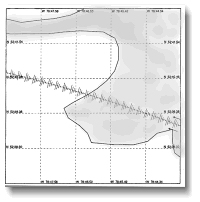

 
|
|
|
|
|
||
|
|

Sensor a Revolution in Spill Detection
Detecting spilled oil that has washed up on a remote beach can be like finding a needle in a haystack. Because certain airborne sensors used to track spills have a narrow field of view, it can take hours of flight time to locate a spill and several more to carry out the physical inspection needed to verify sensing data. In difficult environments, such as in heavily weeded waters, along shorelines and in ice and snow, even the most advanced sensors have proven unreliable, leaving some spills undetected and sensitive environments and species at risk. Beginning early this year, the world's most advanced system for detecting and classifying oil spills will begin operation aboard a DC-3 aircraft based in Ottawa. Developed with the help of a consortium of agencies that includes Environment Canada and the U.S. Minerals Management Service, the Scanning Laser Environmental Airborne Fluorosensor (SLEAF) is the first real-time sensor able to detect and classify oil in even the most difficult environments. This sensor collects fluorescence data from various surfaces in the marine and terrestrial environment. It does this by shining a beam of ultraviolet light onto the surface of the Earth, causing certain compounds-including polycyclic aromatic hydrocarbons (PAHs) found in petroleum oils-to become excited and give off light in the form of fluorescence. Few other compounds in the environment show this tendency. In addition, different classes of oil fluoresce with different intensities and exhibit different spectral signatures, meaning that the bands of colour in each class's spectrum are unique. SLEAF is the new generation of the Laser Environmental Airborne Fluorosensor (LEAF), which was developed in Canada in 1992. The main shortcoming of the original fluorosensor was that it illuminated an area only 10 centimetres wide and 30 centimetres long at an altitude of 100 metres, making it easy to miss spills on beaches and shorelines, where oil tends to pile up in a narrow band at the high-tide line. The new sensor is equipped with a high-powered laser strong enough to operate at an altitude of 600 metres-giving it a field of view six times as large as that of LEAF. One of two conical scanning mirrors is used to direct the laser beam in a circular pattern, enabling it to collect 400 samples per second in a swath up to 200 metres wide. Advanced detection and classification algorithms enable SLEAF to detect and classify contamination as light refined, crude or heavy refined oil, as well as estimate the percentage of oil coverage on either side of the flight path. 
SLEAF survey charts will include surface features, latitude and longitude, and the survey track. The lines extending from each side of the survey track represent oil coverage detected. Factory acceptance tests conducted on the new scanning laser fluorosensor have proven the technology capable of detecting and classifying even minute quantities (only 0.5 per cent of the total area illuminated) of a weakly fluorescing oil on a sand background. Used properly, this kind of precise information will help to mitigate the potentially disastrous effects of an oil spill on sensitive marine and coastal environments by eliminating the need for costly and time-consuming physical inspections, and by directing responders to sites that require remediation. |
|
|
Home | Air | Atmospheric Science | Climate Change | Environmemental Action | Habitat | Pollution | Species at Risk | Technology | Water | Weather | Wildlife |
|
|
| Help
| Search
| Canada Site |
|
||
|
The Green LaneTM, Environment Canada's World Wide Web site
|
||
|
|
||
|
|
||